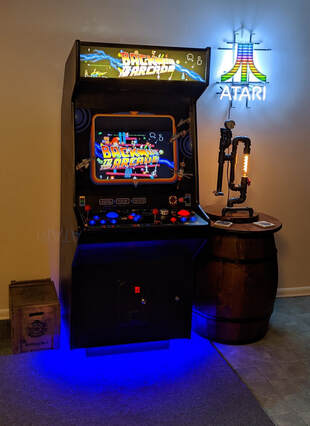What is a Raspberry Pi? It is a small (about the size of a pack of cigarettes) computer that runs open source Linux operating systems. And best of all it is only $35. Add a few more $$ for a case, power supply, and maybe a heat sink and fan and you may hit $60. Not bad for a computer that will power a complete vintage arcade machine running hundreds of games. Not to mention that the entire operating system, configuration files, and hundreds of games are kept on a Micro-SD card (puts shame to the microfilm from the old James Bond films of the 60’s/70’s). But I digress.
The operating system of choice for vintage gaming is Retropie, which is what I am using. Because of the open source nature of this system, I was able to do some custom configuration of my project. I am not a coder, and definitely didn’t know a thing about coding in Linux when I started this project but fortunately it builds on the BASIC programming that I learned back in high school almost 35 years earlier. So with a little help (ok, a LOT of help) from Google, and some reverse engineering I have been able to muddle through it and figure things out. Fortunately there are quite a few people building vintage arcade systems and I was able to tap into that community. One of the best resources for me has been the Retropie Forum where you can find me as DRB. I talked about controls in an earlier chapter, and how I came to the configuration I chose but this may be a good place to talk about the software side of it. One thing I have noticed about many of the posts on the internet is that it appears that most of the vintage system builders are building systems a bit later than mine. Many of them focus on the fighting games that came later in the 80’s and into the 90’s as well as more Nintendo and Sega systems. Due to my impressionable years being late 70’s to early 80’s, my drive was to build a system with the games from that era which makes me more of an Atari guy I guess.
Now that I brought it up, I’ll take a minute to talk about MAME. MAME, or Multiple Arcade Machine Emulator is what makes all of this possible in the first place. MAME is a project developed to preserve the history of vintage video games and how I got involved in this whole project many, many years ago. I won’t go into all the details here, but you can click on the link above to learn more about the MAME project. Another thing to note is that I am not limited to AdvanceMAME, I can use different emulators as needed for my games, but as I mentioned AdvanceMAME is the best at handling the trackball/spinner games so most of my games run on this system which uses ROMset version 106.
If you want to know if a particular game will run on AdvanceMAME version 106 feel free to leave a question here or contact me directly and I will do my best to answer, but please do not ask me where to get ROMs. Continue to Part 8 - Game Configurations Intro | The Games | Control Panel Configuration | The Controls | Control Panel Lights | Research | Specific Games | Hardware & Software | Game Configurations | Cabinet Build | Artwork | Bonus | Leaderboard | Summary
0 Comments
Leave a Reply. |
Dan BlanchardThis is my collection of tips, tricks, and projects that I have made over the years while enjoying my various hobbies. Categories
All
Archives
July 2020
|
Site powered by Weebly. Managed by iPage






 RSS Feed
RSS Feed